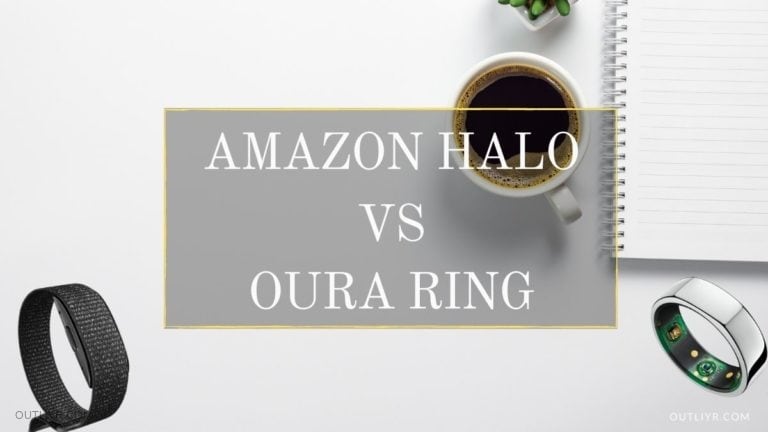Oura is the original favorite wearable of self-quantifies everywhere.
Can Amazon Halo, a new product poised to disrupt the wearable market compete?
I’ve used my Oura daily for over three years. I received an early release Amazon Halo which I tested throughly, and reviewed. What follows is my comparison and review of the Amazon Halo to the Oura Ring. Each has its own specialties and appeal to different folks.
Unboxing and Initial Observations
As a ring, the Oura requires careful sizing.
About a week after ordering, I got a sizing kit in the mail. I wore two different fake (plastic) rings for a full day and night to determine my ideal size. Then I put in my size 13 order and patiently waited four more days. All-in-all, initial order to real ring on my finger took two weeks. Quite long in today’s world of two-day delivery.
The ring came nicely packaged. But! I didn’t realize it’s made of plastic rather than metal. I expected heartier construction. Immediately I began to worry about scratching it. As I wrote in my guide to Oura Ring tips, tricks, and hacks, the ring feels semi-fragile. I remove it when lifting weights or handling rugged objects.
Halo, on the other hand, arrived promptly after ordering. It’s a fabric band that comes in three sizes and three colors. To my surprise, Halo weighs little. Though the fabric feels strong, the sensor itself feels flimsy. Setup was easy. I generally skip instructions and immediately discard manuals. Luckily, Amazon sent an email that broke down the process graphically.
Both devices are relatively minimalist, yet I’ve still snagged my Halo on jackets and backpacks.
Winner: Oura
Price
Price is a key differentiator between these two.
Oura Rings normally go for $299 for the basic model, and more for diamond, gold, or other specialties.
Halo costs just $100 upfront (limited time $65 sale right now), but then has an additional $4 per month subscription cost.
The devices break even after about four years from purchase.
Few electronic devices last that long (though my Oura is getting close).
Winner: Halo
Battery
Both devices can have excellent battery life.
Better than most wearables, if used properly.
I care most about the how long the battery lasts (more important), and charge speed.
Both wearables use proprietary chargers. I have a feeling I’ll accidentally break the flimsy Halo clamp-like charger any day now. Oura’s is solid, and the ring’s base plugs into a standard USB-C cord.
The batteries last:
- Oura: 7-days
- Halo: 2-6-days*
My charge speeds are as follows:
- Oura: 20-80-minutes to full charge
- Halo: 90-minutes to full charge
Amazon claims a 7-day battery life, but my in my testing I rarely exceeded 5-days.
*Problems arise should you choose to enable Halo’s voice analysis mode. The battery drops from an impressive 7-days down to less than 2-days.
Winner: Oura
Sleep
Can Halo compete with the industry-leading Oura for sleep tracking?
Where Oura discards questionable data (and shows it as a data gap in the app), Halo guesses where it should belong. Each approach has its benefits, but I prefer to have the most accurate data possible.
Halo measures most of the sleep metrics as Oura:
- Total time in bed, asleep, and awake
- Time in each sleep stage (REM, Deep, Light)
- Number of sleep disturbances
- Sleep temperature
- Efficiency of sleep
Indeed, after three-years of nightly calibration, I found Oura’s sleep scores to more closely match my perceived sleep quality.
Halo’s sleep metrics were consistently less accurate, though not too far behind. If they had a way to disable bluetooth at night I would track my sleep with it more.
I prefer Oura.
Winner: Oura
Fitness & Movement Tracking
Here’s a little secret:
Neither device tracks workouts well.
No GPS, or ability to collect more frequent health vitals.
Halo quantifies activity with a “points” system:
- Intense activity: 2 points every 1 minute
- Moderate activity: 1 point every 1 minute
- Light activity: 1 point every 20 mins
- Sedentary time (over 8 hours): -1 point every hour
The activity screen prominently shows your total weekly points, with a goal of 150+ per week. You can scroll through the section and find the more classical metrics like calories burned, and distanced walked.
Oura, on the other hand, gives a composite 0-100 activity score taking over a dozen factors into account. At a glance you’ll see:
- Progress towards a custom calorie burn goal
- Step count
- Total calories burned
- Walking equivalent (converting the day’s different physical activities into an equivalent walking distance)
- How often you move and train
Oura also imports workouts from Apple Health. So if you use multiple wearables (as I do), it incorporates all the data into your scores.
Winner: Oura
Recovery, HRV, Heart Rate
No comparison here.
Aside from sleep, Halo doesn’t track recovery.
Oura wins by a landslide. With unmatched metrics data points like:
- Resting heart rate (RHR)
- Heart rate variability (HRV)
- Respiratory rate
- Body temperature
- Recovery index
- Time of lowest heart rate
Each of which contributes to your “readiness” score. Before I structure my workouts, I consult my Oura readiness score and plan accordingly. Push too hard with a low score, and your injury risk skyrockets.
Winner: Oura
Voice & Tone
Progressing from Alexa and the Echo, Amazon has masterfully embedded voice analytics into a small wearable.
Voice analysis is Halo’s flagship feature.
I’m blown away by how well it works. The setup required me to read six random passages. I breezed through it in two minutes flat.
Amazon constantly samples only your individual voice throughout the day to rate:
- Positivity (high or low)
- Energy (high or low)
From there it accurately identifies the strongest emotions and breaks your day down into “notable moments”. With a quick scroll, you can understand how you came off to the rest of the world.
Supposedly, this feature can improve your conversations, relationships, and thus life.
I see all kinds of potential use cases:
- Automatic coaching on calls with clients
- More effective practice for speeches
- Finding hidden sources of stress
But I’m not embracing the technology whole-heartedly:
- Kills battery in 2-days instead of 7
- Voice data is powerful
I trust few companies with my biometric data. In fact, I had serious second thoughts about giving Amazon my voice just to test the feature. Who knows where that data will end up. Companies would pay handsomly for access to your unique voice signature.
Bodyfat Tracking
Another unique feature of Halo, is the ability to track body fat.
Using your phone and their app, you strip down to minimal clothing and rotate as the software creates a 3D “scan” of your body.
If that sounds too good to be true, it’s because it is.
Lighting makes a huge difference. As does timing. If you want decent results, you must be consistent with everything:
- Time of day
- Before or after eating
I recommend first thing in the morning, under the same light to control as many variables as possible.
Apparently, their body fat measurement is as accurate as the clinical standards:
- Dual-energy X-ray absorptiometry (DXA scan)
- Bod Pod
Not in my experience. For my first experiment I took two pictures. One in the late evening, and the next in the early morning.
What did I find?
Within eight hours my body fat percentage fluctuated slightly more than 2.5 percent. Possible, but highly unlikely.
Their technology should become more accurate as more people contribute their data, but I’m not yet impressed.
Data Summaries & Recommendations
Amazon gives users great, actionable content.
Based on your data, they show relevant articles, videos, tutorials, and pseudo virtual coaching.
A special app tab called “labs” consolidates comprehensive health information. In it you’ll find:
- Nutrition
- Mindfulness
- Tone
- Sleep
- Activity
Use the Halo to identify problems, watch relevant mini-courses, make changes, and then analyze your results.
Oura doesn’t offer the same customizable content yet (though it’s probably in the works). Instead, your data automatically generates a weekly trend report. I use it to identify patterns and reflect on my week.
I find Oura’s report incredibly useful and check it religiously. Sometimes I notice correlations that I didn’t when viewing individual days. Great for checking the health effects of travel, big deadlines, or a week of downtime.
Additionally, they send weekly newsletters with relevant health tips. Plus their knowledge base is chock-full of useful articles.
Winner: Tie
Wearables Compared
I like both Oura and Halo. Each has their own pros and cons.
Oura is the wearable of choice for data nerds, biohackers, and those interested in advanced health optimization. Oura is established and renowned among elite athletes for impressive biometric tracking accuracy.
Halo is geared towards beginners with a low upfront-cost, health program recommendations, features geared around general life improvement, and simple interpretation.
Here are some of the key differentiators:
| Halo | Oura | |
| Price | $100 + $4/month | $399 |
| Specialty | Tone + body fat tracking | Minimalist size + extreme accuracy |
| Best for | Barebones health | Intermediate + advanced self-quantification |
| Wearable material | Fabric | Plastic/Metal |
| Battery life | 1.75-6 days | 6-7 days |
| Sleep tracking | Good | Great |
| HRV tracking | No | Yes |
| Recovery tracking | No | Yes |
| Syncs data from other apps | No | Yes |
| Private & secure data | No | Yes |
| Trend reports | No | Yes |
| Fitness tracking | Good | Good |
| Learning & coaching material | 100+ programs | Emails + blog posts |
If data accuracy matters, Oura is a league ahead.
Final Verdict: Should You Buy The Amazon Halo or Oura Ring?
Neither wearable is objectively best.
Your best choice depends on your experience:
- Beginner: Amazon Halo
- Intermediate & Advanced: Oura Ring
Oura has been the long-standing choice of professionals, competitive athletes, and those looking for the most accurate data. It’s the most physically minimalist yet comprehensive wearable on the market. It’s here to stay, having proven itself over years of wear-and-tear.
Amazon’s Halo device is the latest major wearable released, and a good choice for beginners. At $100, even with a $4 monthly subscription (after 6 months free), it’s more affordable. The data is fairly accurate and it offers a few unique features. If you don’t mind handing over your invaluable biometric to Amazon, this could be your perfect device.
After thorough testing, I still prefer my Oura Ring. I’ve worn mine religiously for over three years. If I had to choose one, I stand by my choice.
Who do you think wins the Oura vs Halo battle?




